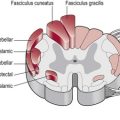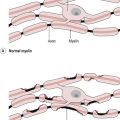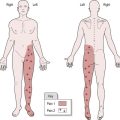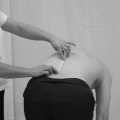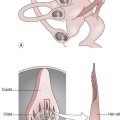Objective assessment (functional assessment)
Observation of how the patient moves
Patient
Note: If the patient is able to walk, then the therapist will also need to complete a full gait analysis (S3.19).
Therapist
While the patient performs the function the therapist needs to note:
The quality of performance/movement analysis
Normal requirements of the task
Patient observation
Are there any obvious asymmetries? Does the movement adhere to biomechanical principles? Altered alignment could indicate: (1) instability due to hypotonia or weakness; (2) a restriction due to hypertonia, soft tissue shortening or pain, or (3) altered sensation. More detailed postural alignment and differential diagnosis of cause should be investigated later in the assessment.
Is the movement smooth, coordinated, well timed, effortless? Poor quality movement could result from a motor or sensory impairment or a problem with integration. Ataxia (S3.26) also manifests as incoordinated movement of the limbs or trunk but is due to a dysfunction of the cerebellum (S2.12).
Do they use any trick movements during functional activities? Is the movement successful in achieving the motor goal? Compensation is defined as a behavioural substitution adopted to complete a task (Shumway-Cook and Woollacott 2007). As motor control is goal orientated, a successful compensatory movement may result in the central nervous system adopting this strategy in the long term rather than finding other solutions. This may limit the individual from recovering to their full potential (Cristea and Levin 2000). While it is acknowledged that compensations also occur within a healthy population, it is this lack of choice of movement solutions in neurologically impaired patients that limits their function (Raine et al. 2009). Therefore perhaps therapy should be aimed at facilitating a choice of compensations or modifying the most inefficient ones.
Do they use normal movement patterns? Do they use gross movement patterns? This is due to the inability to fractionate or break up a basic pattern of movement in order to make it functional. Fractionation is defined as the ability to move a single joint without simultaneously moving other joints (Shumway-Cook and Woollacott 2007). All tasks require a combination of muscle synergies. For example, the task of reaching requires shoulder flexion, elbow and wrist extension with finger flexion to grip. Therefore, an individual who uses a gross pattern involving flexion at all joints will be ineffective in achieving their goal. This is one of the signs of spasticity (S3.21).
Do they present with dystonia? Dystonia is a syndrome characterized by abnormal, sustained muscle contractions often resulting in persistent abnormal postures at the extremes of movement range. The movements are often twisting and range in speed and amplitude. Abnormal co-contraction is common and the contractions often elicit pain. Dystonia is associated with lesions of the basal ganglia (S2.11), particularly the indirect pathway of the putamen nucleus. However, there are several subtypes which may vary in cause.
Do they present with athetoid movements? Athetoid movements are slow writhing twisting movements of small amplitude primarily involving the upper limb.
Do they present with choreiform movements? Choreiform movements are rapid, jerky movements often of large amplitude. This presentation is observed in Huntington’s chorea and caused by a lesion of the basal ganglia (indirect pathway).
Do they present with clonus? Clonus is most commonly seen at the ankle and presents as a rhythmic oscillation between plantar flexion and dorsiflexion. This occurs when a brief stretch of the plantar flexor muscle occurs and the tension is maintained, e.g. when placing the affected lower limb of a patient up onto the footplate of a wheelchair.
Do they present with any associated reactions (ARs)? An AR is a temporary involuntary movement primarily involving the upper limb. The initiating triggers are widely variable and individual to the patient but can include increased effort during movement (Bhakta et al. 2001), muscular instability, yawning, coughing, pain, fear, urinary tract infection. Little evidence exists as to the underlying cause of these reactions but the time delay in onset after the original lesion seems to implicate maladaptive changes which lead to a reduced ability to inhibit unwanted movement. This is one of the signs of spasticity (S3.21). When associated reactions are evident, it is important that the therapist records:
• When the AR occurs precisely, e.g. during mid-stance of the right lower limb
• The excursion of the movement, e.g. elbow flexion occurs to a maximum of 90°
• The pattern of the movement, e.g. elbow flexion with forearm pronation and some finger flexion
• How long the AR remains, e.g. the upper limb immediately returns to normal when the patient stops walking. There is no AR in standing.
• Active range of movement (AROM)
Are there any obvious limitations in AROM? (S3.28), e.g. taking off a jacket or jumper requires good AROM of the shoulder and trunk in certain directions. Any limitation may be a result of soft tissue shortening, muscle weakness (S3.30), pain (S3.29), altered sensation (S3.23) or altered muscle tone (S3.21)
Do they lose balance or stumble during any activity? (S3.32, 34). This may be a direct result of a deficit affecting the balance systems (vestibular system/vision/proprioception) or a functional consequence of various other symptoms, such as poor trunk stability, altered muscle tone or sensation.
Analysis
Having completed the observation of the patient during a functional activity and noted any deviations, the therapist can begin to reason what the potential causes of the dysfunction could be based upon the task requirements. The hypothesis generated will need to be tested and confirmed using the specific assessment tools (S3.19–34).
Bhakta, BB, Cozens, JA, Chamberlain, MA, et al. Quantifying associated reactions in the paretic arm in stroke and their relationship to spasticity. Clinical Rehabilitation. 2001; 15:195–206.
Cristea, MC, Levin, MF. Compensatory strategies for reaching in stroke. Brain. 2000; 123:940–953.
Raine, S, Meadows, L, Lynch-Ellerington, M. Bobath concept: theory and clinical practice in neurological rehabilitation. Oxford: Wiley-Blackwell; 2009.
Shumway-Cook, A, Woollacott, MH. Motor control: translating research into clinical practice, ed 3. Philadelphia: Lippincott Williams and Wilkins; 2007.

